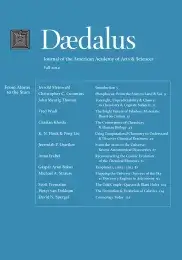
Phosphorus: From the Stars to Land & Sea
The chemistry of the element phosphorus offers a window into the diverse field of inorganic chemistry. Fundamental investigations into some simple molecules containing phosphorus reveal much about the ramifications of this element’s position in the periodic table and that of its neighbors. Additionally, there are many phosphorus compounds of commercial importance, and the industry surrounding this element resides at a crucial nexus of natural resource stewardship, technology, and modern agriculture. Questions about our sources of phosphorus and the applications for which we deploy it raise the provocative issue of the human role in the ongoing depletion of phosphorus deposits, as well as the transfer of phosphorus from the land into the seas.
Foresight, Unpredictability & Chance in Chemistry & Cognate Subjects
In numerous branches of natural philosophy, the ways in which major, transformative advances are achieved are often cloaked in mystery, or arrived at through a fortunate concatenation of circumstances. This theme is pursued here with the aid of some examples from my own work on catalysis (the speeding up of the attainment of chemical equilibria), as well as from the work of others. The emergence of the maser (forerunner of the laser), the development of positron emission tomography, and the creation of blood-glucose sensors for use by those suffering from type 2 diabetes are among the innovations adumbrated here. In addition to describing the unpredictable nature of much scientific discovery, I also describe areas in which new chemical technology will be especially beneficial to society.
The Bright Future of Fabulous Materials Based on Carbon
Our current civilization belongs to the organic materials age. Organic materials science pervades nearly all aspects of our daily life. This essay sketches the evolution of materials science up to the present day. Plastics as textiles and structural materials dominate human civilization. The element carbon is at the core of this development because of its diverse interconnections with itself and other elements of the periodic table. While silicon will not be supplanted from its role in electronics, carbon will provide the most versatile electronics applications, through inexpensive, flexible electronic devices.
The Convergence of Chemistry & Human Biology
Over the past two decades, “chemical biology” has emerged as the term of choice to describe the interface between chemistry and biology. As its name suggests, the field draws upon chemical insights and tools to understand or engineer living things. This essay focuses on the scientific, societal, and pedagogical potential of an emerging frontier for chemical biologists: namely, the study of Homo sapiens. Khosla’s goal is to highlight the opportunities and challenges presented to chemistry by human biology at a time when it costs less to sequence an individual's genome than it does to buy a car.
Using Computational Chemistry to Understand & Discover Chemical Reactions
Chemistry, the “science of matter,” is the investigation of the fabulously complex interchanges of atoms and bonds that happen constantly throughout our universe and within all living things. Computational chemistry is the computer modeling of chemistry using mathematical equations that come from physics. The field was made possible by advances in computer algorithms and computer power and continues to flourish in step with developments in those areas. Computational chemistry can be thought of as both a time-lapse video that slows down processes by a quadrillion-fold and an ultramicroscope that provides a billion-fold magnification.
Reconstructing the Cosmic Evolution of the Chemical Elements
The chemical elements are created in nuclear fusion processes in the hot and dense cores of stars. The energy generated through nucleosynthesis allows stars to shine for billions of years. When these stars explode as massive supernovae, the newly made elements are expelled, chemically enriching the surrounding regions. Subsequent generations of stars are formed from gas that is slightly more element-enriched than that from which previous stars formed. This chemical evolution can be traced back to its beginning soon after the Big Bang by studying the oldest and most metal-poor stars still observable in the Milky Way today. Through chemical analysis, they provide the only available tool for gaining information about the nature of the short-lived first stars and their supernova explosions more than thirteen billion years ago. These events set in motion the transformation of the pristine universe into a rich cosmos of chemically diverse planets, stars, and galaxies.
Exoplanets, 2003–2013
Cosmologists and philosophers had long suspected that our sun was a star, and that just like the sun, other stars were also orbited by planets. These and similar ideas led to Giordano Bruno being burned at the stake by the Roman Inquisition in 1600. It was not until 1989, however, that the first exoplanet – a planet outside the solar system – was discovered. While the rate of subsequent discoveries was slow, most of these were important milestones in the research on extrasolar planets, such as finding planets around a pulsar (a compact remnant of a collapsed star) and finding Jupiter-mass planets circling their stars on extremely short period orbits (in less than a few Earth-days). But the first decade of our millennium witnessed an explosion in the number of discovered exoplanets.
Mapping the Universe: Surveys of the Sky as Discovery Engines in Astronomy
Astronomers can map the sky in many ways: observing in different regions of the electromagnetic spectrum, obtaining spectra of stars and galaxies to determine their physical properties and distances, and repeatedly observing to measure the variability, explosions, and motions of celestial objects. In this review I describe recent surveys of the sky astronomers have carried out, focusing on those in the visible part of the spectrum. I describe in detail the Sloan Digital Sky Survey, an ongoing imaging and spectroscopic survey of over one quarter of the celestial sphere. I also discuss some of the major surveys planned for the next decade, using telescopes both on the ground and in space.
The Odd Couple: Quasars & Black Holes
Quasars emit more energy than any other object in the universe, yet are not much bigger than our solar system. Quasars are powered by giant black holes of up to ten billion (1010) times the mass of the sun. Their enormous luminosities are the result of frictional forces acting upon matter as it spirals toward the black hole, heating the gas until it glows. We also believe that black holes of one million to ten billion solar masses – dead quasars – are present at the centers of most galaxies, including our own. The mass of the central black hole appears to be closely related to other properties of its host galaxy, such as the total mass in stars, but the origin of this relation and the role that black holes play in the formation of galaxies are still mysteries.
The Formation & Evolution of Galaxies
Weighing in at 1042 kilograms and measuring 1021 meters across, galaxies are perhaps the most awe-inspiring objects known to mankind. They are also the only places in an otherwise dark and unforgiving universe where stars and planets are able to form. In the past five to ten years we have made enormous progress in understanding when galaxies came into being and how they changed and evolved over the course of cosmic time. For the first time, we have a rudimentary idea of what our own Milky Way looked like in the distant past, and we can now simulate Milky Way–like galaxies inside powerful computers. As we are starting to understand what happened in our galaxy's past, we are now turning to the question of why it happened. Untangling the complex physical processes that shape galaxies is extremely difficult, and will require continued advances in computers and information from powerful new telescopes coming online in the next decade.
Cosmology Today
We seem to live in a simple but strange universe. Our basic cosmological model fits a host of astronomical observations with only five basic parameters: the age of the universe, the density of atoms, the density of matter, the initial “lumpiness” of the universe, and a parameter that describes whether this lumpiness is more pronounced on smaller physical scales. Our observations of the cosmic microwave background fluctuations determine these parameters with uncertainties of only 1 to 2 percent.
